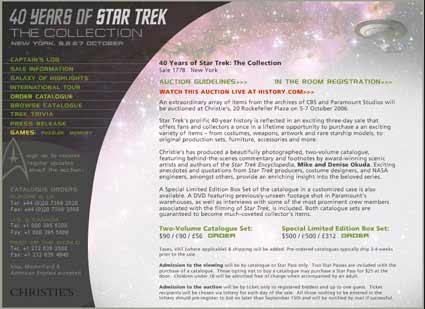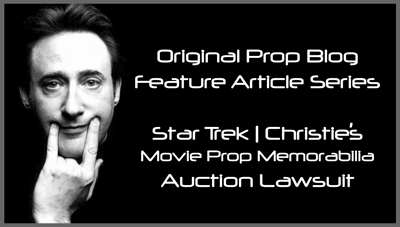As reported here Friday (see “Star Trek Collector Sues Christie’s, CBS & Paramount Studios for $7 Million Dollars“), a collector is suing CBS and Paramount Studios and Christies for $7 million dollars, claiming that the pieces won at the 40 Years of Star Trek: The Collection auction event were “fake” or inauthentic.
As I noted in my previous article, the main item this collector cites as the basis for his lawsuit – Data’s poker visor – is an item I happened to have had a friend bid on for my behalf at the auction. Watching the event live over webcast, I distinctly recall that the auctioneer amended the description to note that the visor being offered was not the one filmed and seen in that particular episode. I even have notes to this effect that I made in real time on a private forum archived.
I am surprised that Christie’s has not yet made this information publicly available, in that the auction was broadcast live on the Internet and on television via the History Channel. Given the amount of mainstream media press coverage, it is a shame that Christie’s is receiving so much negative press over something that likely is a non-issue, or reflective of the collector’s lack of understanding of the nature of authenticity, as it relates to original props and wardrobe and the hobby.
I am very pro-consumer/pro-collector, which is reflected in the content of this blog. But in this case, unless it can be proven that the visor was not “Original” (see What is “Original”? and my definition excerpt at the bottom of this article), I side with Christie’s in this case, assuming my recollection and notes pertaining to the lot description amendment is accurate, and the piece came from the Paramount Studios archives (which I’ve seen no evidence that disputes this characterization of all of the pieces offered at the event).
The items offered for sale came direct from the CBS & Paramount Studios archives, per Christie’s. Mike and Denise Okuda cataloged the items for the sale event. Per the Official Press Release, the items were “never-before-released”. It is rare that original props and wardrobe are offered direct from a studio and with clear title (i.e. are not stolen or previously gifted with no studio paperwork affirming this).
Not filmed, or seen on screen, does not mean the item is “fake”, inauthentic or not “Original”.
The OPB Lexicon is filled with a variety of terms that define the precise use and employment of a given prop or wardrobe: “hero”, “stunt”, “back-up”, “screen-matched”, “background”, “prototype”, “close-up”, “filmed’, “made for production”, “one-of-a-kind”, “master prop”, “production used”, “screen-used”, “seen on screen”, “static”, “working”, etc. All of these various kinds of props are all still “Original” and authentic.
I would be interested in seeing the auction transcripts/video to review exactly what the auctioneer said to modify the description for the visor before accepting bids. I would hope that Christie’s would make the applicable video/transcript available in an effort to resolve the dispute and arm the media with information and facts related to the fundamentals of authenticity and original props and wardrobe. This event could serve to better educate the public on better understanding the hobby and perhaps benefit potential collectors on what to be aware of and auction houses on how to more carefully market their pieces.
What is “Original” excerpt:
An artifact from a film or television production that was:
1) made by the production or acquired by the production,
2) during the production, and
3) used or intended to be used during the production.
All three of these criteria must be met in order for a piece to be considered “Original.
Full coverage of this story can be found on the Original Prop Blog series of articles (Auction Houses and Prop Dealers | Christie’s | Christie’s ‘Star Trek’ Lawsuit):
Jason DeBord


